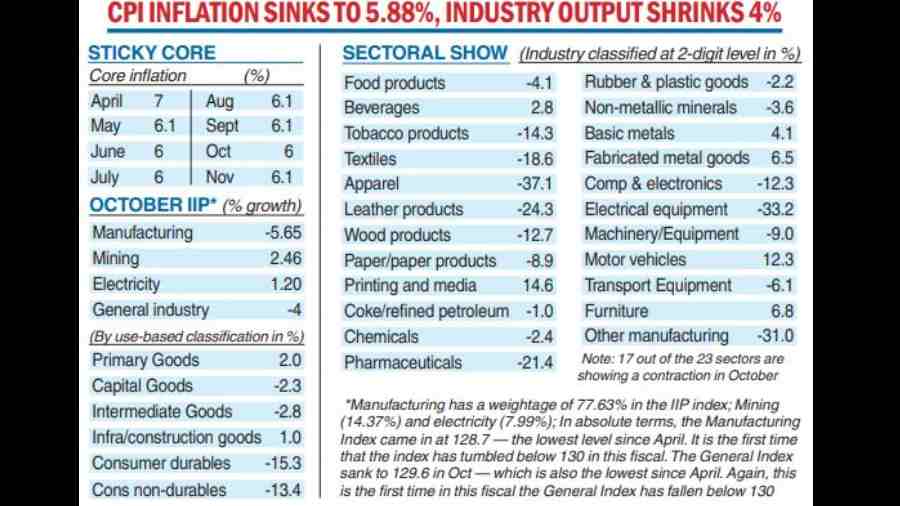The comfort of retail inflation falling to an 11 month-low of 5.88 per cent in November has been tempered by sticky core inflation which remains at 6 per cent even as the industry growth rate contracted 4 per cent in October.
Retail inflation fell below the RBI’s threshold level of 6 per cent led by a sharp fall in vegetable prices. “Given the pending pass through of higher input costs by producers and sustenance of robust demand for services, core inflation is likely to remain elevated,” Aditi Nayar, chief economist, Icra said.
Rajani Sinha, chief economist, CareEdge said: “Food inflation fell to an 11-month low owing to deflation in vegetables and edible oils components. With this, inflation retreated into RBI’s tolerance band earlier than expected.
The concerning aspect was the stickiness in core inflation which remained above 6 per cent. The upward pressure on services inflation has led to the strengthening of core inflation.”

Bank of Baroda chief economist Madan Sabnavis said although there is an easing in food prices, the core component continues to be irksome, with clothing and footwear, fuel and light and the miscellaneous categories witnessing high inflation of above 6 per cent each.
“Core inflation has remained higher than 5.75 per cent in the last 19 months. While the headline inflation is under the RBI’s target, sticky core inflation needs continuous monitoring and the RBI is unlikely to lower its guard against inflation. We still expect the RBI to undertake a 25bp hike in February 2023 monetary policy,” Sunil Sinha, principal economist, India Ratings and Research, said.
Factory output
Industrial production contracted 4 per cent in October, the sharpest fall in 26 months mainly because of a decline in the output of manufacturing and consumer durable sectors, according to official data released on Monday.
The index of industrial production (IIP) had grown 4.2 per cent in October 2021. The previous low was (-) 7.1 per cent in August 2020. As per IIP data released by the National Statistical Office (NSO), the manufacturing sector’s output declined 5.6 per cent in October 2022 against a growth of 3.3 per cent recorded in the year-ago month.
The data showed that most of the internals of the manufacturing segment contracted indicating broad-based fall in output. Mining output rose a meagre 2.5 per cent and power generation increased 1.2 per cent.
The data further revealed that capital goods output declined 2.3 per cent in October against a contraction of 1.6 per cent in the same month last year. The production of consumer durables too shrank 15.3 per cent and for consumer non-durables, the decline was 13.4 per cent. Sabnavis, said capital goods has been disappointing as it indicates that investment is lagging.











